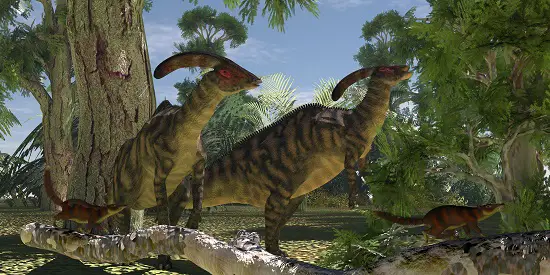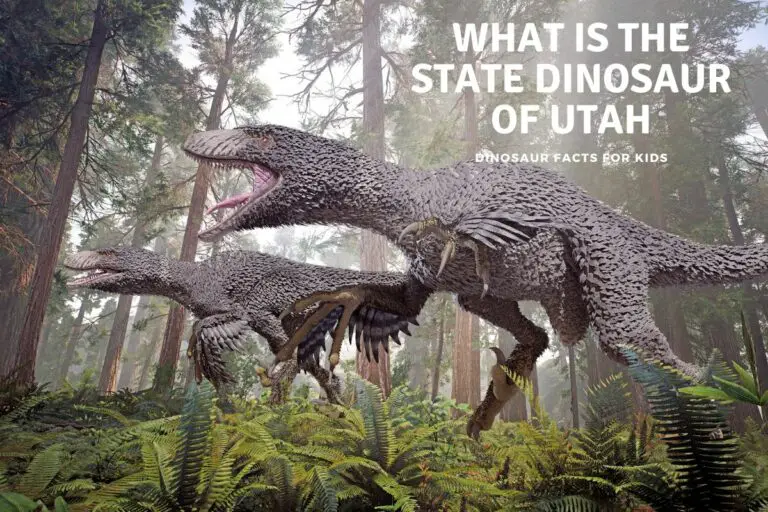How Big Was Parasaurolophus?
Parasaurolophus makes an appearance in Jurassic World Dominion pretty near the beginning when it is shown to be a little taller than a horse, and fairly friendly. We take a look at how big a Parasaurolophus actually was by looking at the fossils of this Crested Dinosaur we have found so far.
The Parasaurolophus was a late cretaceous dinosaur that measured about 26-30 ft long and weighed 2.5-5 tons and its height was around 10 ft tall at the hips. It is well known for its prominent crest that could be 6 ft in length .It lived about 77-73 million years ago in what is now North America.
Before we start looking at its size, it seems right that we actually take a look at what the Parasaurolophus actually was, in case you are not 100% sure.
What was a Parasaurolophus?
The name Parasaurolophus translates to “near crested lizard” which refers to the prominent crest featured atop its large head. Parasaurolophus was a large, herbivorous dinosaur that was believed to both walk bipedally, and additionally as a quadruped ( on all four legs as well as its two hind legs)
The broader species was known as the Parasaurolophus walkeri, with the first specimens being discovered in Alberta, Canada, back in 1922 by William Parks. Since then, specimens have also been found in the US (New Mexico and Utah), as well as in China (Heilongjiang Province).
We actually have a whole page dedicated to this beautiful dinosaur here on the site. So you can check out more Parasaurolophus facts on the link here and below.
but on this page we, mostly take a look at how large the parasaurolophus was, and the size of other defining parts like that huge crest on its head.

How Big Was Parasaurolophus: The Numbers
From a human perspective, Parasaurolophus was a large beast, estimated to grow up to 31 feet (9.45m) in length. An exact height has not been determined since most remains of this dinosaur are incomplete skeletons.
The most complete specimen found to date is that of a juvenile Parasaurolophus, so while we have some idea from these remains of the growth stages of this dinosaur, an exact height has not been able to be determined as of yet
When one includes the crest, the skull of Parasaurolophus measures up to 5 feet 3 inches in length (about 1.6m). Another species, Parasaurolophus tubicen had a skull and crest measuring even larger at 6 feet 7 inches (more than 2m).
Other remains have shown that Parasaurolophus was a strong and robust dinosaur, well-built and capable, perhaps even more-so than its dimensions initially suggest. It is estimated to have weighed around 2.5 to 5 tons or 5-10,000 lbs. –
With that in mind, it would have been unlikely that it could have been roped and held by a single guy on horse back – just a note for the writers of Jurassic World Dominion there!
Specimen: RAM 140000
Further above, we mentioned a juvenile Parasaurolophus that is among the most complete fossilized specimens found to date. This specimen is known by its number RAM 140000, with RAM standing for Raymond M. Alf Museum of Paleontology. It was given the nickname, “Joe” after a volunteer at the museum.
Joe was believed to have lived about 75 million years ago, with the species more generally living in the Late Cretaceous Period, between 76.5 and 73 million years ago. Joe is about 8.2 feet in length (2.5m).
Unfortunately, a complete skull for Joe has not yet been discovered, but a partial braincase indicates that his head was about a quarter the size of the adult specimens that have already been discovered.
Interestingly, it was also discovered that when juvenile, the head crest is placed lower, indicating that it grows longer and more tube-like in shape as the Parasaurolophus grows and matures.

What Function Did Parasaurolophus’ Crest Have?
There are a number of different theories surrounding the function of the Parasaurolophus’ prominent head crest. One very interesting theory that has since been rejected was put forward by Alfred Sherwood Romer, who believed that the crest could have been used as a snorkel, and that Parasaurolophus was a part-aquatic, part-land creature.
Amphibious living was not unknown among the dinosaurs, of course, but the discovery of more complete skull specimens later on seemed to deny that this was the case.
The choice of name for Parasaurolophus is also interesting because it wrongly leads some to conclude that it must be just another form of Saurolophus, or “lizard crest.”
The “para” identifies Parasaurolophus as being like that of Saurolophus, but having one very important difference, namely that the former has a crest that’s hollow, while the latter has a crest that is solid.
This has fueled theories that Parasaurolophus and Saurolophus’ crests were used in different ways.
The Parasaurolophus crest has also been suggested as a kind of framing head support, as well as for defensive use against predators.
The most widely accepted current theory of the function is that it serves as a way of identifying members of different species, but also for communication, thermoregulation, and use as a tool of sexual display when seeking mates.
For use in communication, there is some reason to believe that Parasaurolophus would communicate with each other by creating a distinctive bellowing noise in the resonating chamber of the crest.
Temperature regulation is a widely accepted possibility of a viable and logical function of the crest. It is suggested by its large surface area, but also by its vascular structure. It was P. E. Wheeler in 1978 who put forward this theory after proposing there being a connection of nerves between the brain and the crest.
This would allow for the crest to be used to cool the brain. Similar structures and functions in modern lizards have led contemporary scientists to think that Wheeler’s idea has great merit.
What Did Parasaurolophus Eat?
As we have mentioned, Parasaurolophus was a large herbivorous dinosaur, which means that it exclusively ate plants.
Discovery of Parasaurolophus skull and teeth samples strongly suggest that Parasaurolophus was capable of grinding and chewing in quite a sophisticated manner. Specimens already discovered show the presence of hundreds of teeth that were constantly being replaced, but only with a relatively small number ever being used at one time.
The height of Parasaurolophus at the hips shows that this dinosaur was a capable gatherer, able to reach food sitting at heights of 13 feet or more (4m). What’s more, their beak was smaller than many of their relatives in the Hadrosaur family, which allowed them to eat more precisely and more selectively.
Similar dinosaurs with broader beaks could not do this. Evidence shows that they had a diet of twigs and leaves, as well as pine needles.

What Did Parasaurolophus Sound Like?
Some have described Parasaurolophus as something of a “music maker” because of the apparently trumpet-like sound that it was able to produce. Of course, without living specimens we can’t know this for sure, but study of the skulls and crests of Parasaurolophus remains discovered so far suggests that it could well have had these properties.
Researchers have already reconstructed the inner workings of a crest using plastic pipes, which when blown into produce a musical note like a trumpeter playing a B flat.
Such sounds could have been used as warnings, mating calls, or both along with other uses. Being able to make distinctive sounds has long proven to be a key evolutionary factor in survival.
We have a series of articles on How Big Dinosaurs were and you can follow the links below to check out the size of other popular dinosaurs.
And if you wanted to know some of the smallest dinosaurs ever you can check out the article on the site as well. As although dinosaurs are often thought to be huge monstrous animals there were plenty of small ones as well and we take a look at them on the link above.
Conclusion
At up to 31 feet, 5 tons and 10-13 feet tall Parasaurolophus was certainly no small dinosaur, and although it would have been prey for larger dinosaurs like gorgosaurus and Early T-Rex it did not have to worry about much else if it managed to become fully grown.
Although it had no defensive weaponry it potentially did have a warning call and 2 strong legs to run away from trouble if it came lumbering towards it in the shape of a hungry T -Rex.
References
- https://en.wikipedia.org/wiki/Parasaurolophus#:~:text=Like%20most%20dinosaurs%2C%20the%20skeleton,Paul.
- https://www.dinopit.com/how-big-was-parasaurolophus/
- https://winghamwildlifepark.co.uk/dinosaur/parasaurolophus/
- https://kids.nationalgeographic.com/animals/prehistoric/facts/parasaurolophus
Hi, I am Roy Ford a General Studies and English Teacher who has taught all over the world. What started as a fossil collection became a great way to teach, motivate and inspire students of all ages and all over the world about dinosaurs and from that and children’s love of dinosaurs came the site dinosaur facts for kids, a resource for all ages.






